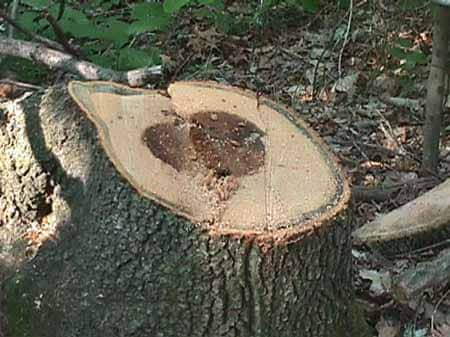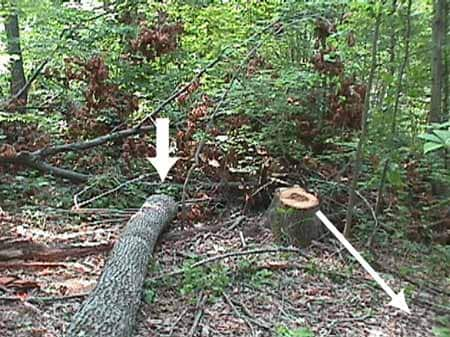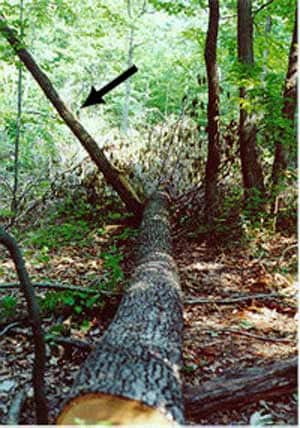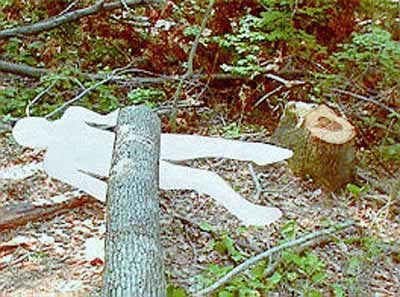Tree Feller Dies After Being Struck by Tree Being Felled in West Virginia.
Investigation # 99WV026-01
Release Date: 8-26-99
SUMMARY
On May 18, 1999, a 39 year-old male tree feller (the victim) died of injuries sustained when he was struck by and then pinned to the ground by the tree he was felling. The victim was felling trees on terrain with a 16% slope. He was in the process of felling an oak. The oak was approximately 16 inches in diameter at breast height and 85 feet tall. He asked the dozer operator working with him to clear a small area next to the base of the tree. He then made a few additional brush clearing cuts for base access. He made a small, open faced notch. His third and final cut left little if any hinge wood. After making his final cut he, moved approximately 4 feet to the side and watched the tree fall. In the process, the tree contacted an oak 24 feet from the base of the tree. The contacted oak was 8 inches in diameter at breast height. As the falling tree contacted the smaller oak, it rolled and the butt cantilevered into the air striking and pinning the victim to the ground. He was pinned diagonally across the abdomen and pelvis. Witnessing the incident, the dozer operator responded by lifting the tree enough to free the victim using the dozer blade to slide the tree up the now-slanted smaller oak. He then slid the victim out. The victim remained conscious. After reassuring the victim, the operator reached in the victim’s pocket and acquired the keys for his truck which was located approximately one quarter of a mile downhill at the landing site. Upon reaching the truck, he realized he had the wrong set of keys and began a lengthy downhill run through the woods. His goal was a house located approximately two miles away at the beginning of the site’s access road. At the home, he called 911 and waited for the ambulance. Riding in with the ambulance, he guided them to the victim. The dozer operator then cleared a landing area for life-flight. Approximately three hours after the incident, the victim was flown to the nearest trauma center where he died later that evening.
The WV FACE Investigator concluded that, to reduce the likelihood of similar occurrences, employers should:
- ensure that tree fellers prepare an escape path and move a safe distance from the base of the tree as it is falling.
- ensure that tree fellers utilize proper directional felling techniques.
- develop, implement, and enforce a written safety program which includes, but is not limited to, training in hazard identification, avoidance, and abatement as well as methods dealing with worker non-compliance.
- designate a competent person to conduct frequent and regular site safety inspections.
- ensure that a timely means for summoning emergency services exists on each job-site.
INTRODUCTION
On May 18, 1999, a 39-year-old male tree feller (the victim) died of injuries sustained when he was struck by and then pinned to the ground by the tree he was felling. On May 21, 1999, the West Virginia FACE Investigator was notified of the death by the West Virginia Division of Forestry via a phone call. On June 7, 1999, the WV FACE Investigator conducted an on-site investigation. The Investigator reviewed the incident with the West Virginia Division of Forestry representative, who then accompanied the Investigator to the site. The logging company’s owner was interviewed as well as one eye witness. The incident site was examined and photographed. Other informational sources and contacts included: death certificate, medical examiner’s report, newspaper articles, West Virginia Division of Forestry, the National Weather Service, and OSHA.
The employer in this incident was a commercial logging company that had been in business for twelve years and employed two employees. The owner and two employees were present the day of the incident. The land was industry-owned. The unmarked, 600 acre timber stand was being selectively logged for saw timber and pulpwood. It was reported that the operation was on schedule.
The owner did not hold Certified Logger status in West Virginia and therefore was operating without a current timber license. Additionally, the operation was being run without the required Division of Forestry applications and subsequent approvals. [Note: The Logging Sediment Control Act of West Virginia (1992) requires that each timbering operation in West Virginia be supervised by a certified logger. To become a certified logger, an individual is required to successfully complete training and pass a test for best management practices (a soil erosion prevention plan) and chain saw safety and possess a current first aid card.1]
The company had no written safety program. The employer (owner) did not indicate that formal company-specific training was provided. The employer did indicate that he had warned the victim numerous times to move a safe distance from the tree when felling as well as requesting that he use directional felling techniques. There was no employee with current first aid/CPR status on the site or a method to summon help. The employer had never experienced a similar incident, and no fatalities had occurred in the company.
The victim’s job at the time of the incident was felling trees. He had been a logger for at least six years. The victim had been cutting for the employer for a total of three weeks when the incident occurred. He had attended the West Virginia Division of Forestry’s chainsaw safety workshop two years prior to the incident. It was reported that the victim rarely established and used an escape path and that the victim was hospitalized a few years earlier after being hit by a tree he was felling while standing near the base. At the time of the incident, the victim was wearing a hard hat, eye protection, hearing protection, chaps, gloves, and boots. He had been cutting 3½ hours prior to the incident.
INVESTIGATION
On May 18, 1999, a 39 year-old male tree feller (the victim) died of injuries sustained when he was struck by and then pinned to the ground by the tree his was felling. The victim was felling trees on terrain with a 16% slope. He was in the process of felling an oak. The oak was 16 inches in diameter at breast height and 85 feet tall. At approximately 10:45 a.m., he asked the dozer operator working with him to clear a small area next to the base of the tree. At 11:00 a.m., he made a few additional brush clearing cuts for base access and failed to establish an escape path. He made a small open, faced notch. His third and final cut left little if any hinge wood (see Figure 1). After making his final cut, he moved approximately 4 feet to the side and watched the tree fall (see Figure 2). The tree fell to the right of the intended clearing. In the process, the tree contacted an oak 24 feet from the base of the tree (see Figure 3). The contacted oak was 8 inches in diameter at breast height. As the falling tree hit the smaller oak, it rolled and the butt cantilevered into the air striking and pinning the victim to the ground (see Figure 4). He was pinned diagonally across the abdomen and pelvis. Witnessing the incident, the dozer operator responded by lifting the tree enough to free the victim using the dozer blade to slide the tree up the now slanted smaller oak. He then slid the victim out. The victim remained conscious and requested the dozer operator to stay by his side fearing a recently sited bear. After 30 minutes of reassuring the victim, the operator reached in the victim’s pocket and acquired the keys for his truck which was located approximately one quarter of a mile downhill at the landing site. Upon reaching the truck, he realized he had the wrong set of keys and began a lengthy downhill run through the woods. His goal was a house located approximately two miles away at the beginning of the site’s access road. Reaching the home at approximately 1:00 p.m., he called 911 and waited for the ambulance. Riding in with the ambulance, he guided them to the victim. As requested by the EMS, the dozer operator then cleared a landing area for life-flight. Approximately three hours after the incident, the victim was flown to the nearest trauma center where he died later that evening.
CAUSE OF DEATH
The medical examiner’s report listed the immediate cause of death as multiple injuries including fracture of the pelvis as well as massive abdominal bleeding.
RECOMMENDATIONS/DISCUSSION
Recommendation #1: Employers should ensure that tree fellers prepare an escape path and move a safe distance from the base of the tree as the tree is falling.
Discussion: Preparing an escape path before felling any tree is imperative for a safe felling operation. Doing so will allow the feller to quickly reach a safe distance from the falling tree. A way of retreat must be planned before felling a tree. CFR 1910.266h(2)(I) requires that before felling is started, the feller shall plan and clear an escape path, and once the back cut has been made, the feller shall immediately move a safe distance away from the tree on the escape path. 2 The victim did not establish a path. Additionally, he remained in a static position only 4 feet from the base of the tree. Having established a path and retreating the recommended diagonal 45 degrees from the expected felling line would have placed the victim in a safe area even with the misdirected fell.
Recommendation #2: Employers should ensure that tree fellers utilize proper directional felling techniques.
Discussion: Directional felling is the safest manual felling method of getting trees on the ground. The proper notch directs the tree’s fall and the hinge wood keeps the tree under control as it falls. CFR 1910.266h(2)(v) requires that a directional undercut be made, and 1910.266h(2)(vi) requires that a back cut be made leaving sufficient hinge wood to hold the tree to the stump during most of its fall so the hinge is able to guide the tree’s fall in the intended direction.2 The victim did not utilize proper directional felling techniques. Having left the proper amount of hinge wood would have ensured that the tree would have fallen into the desired clearing. Consequently, the tree fell approximately 15-20 degrees to the right striking the smaller oak. In doing so, it rolled and the butt cantilevered into the air striking the victim.
Recommendation #3: Employers should develop, implement, and enforce a written safety program which includes, but is not limited to, training in hazard identification, avoidance, and abatement as well as methods for dealing with worker noncompliance.
Discussion: The evaluation of tasks to be performed at the work site form the basis for the development, implementation, and enforcement of a safety program. The key elements of the program should include, at a minimum, training in hazard identification and the avoidance and abatement of these hazards. Additionally, the program should address the steps to be taken in the event of identifying a worker who fails to follow company-established safe work practices. In this incident, the employer did not have a written safety program and therefore had no established means for communicating and enforcing safety expectations. Having established, communicated, and enforced the worker’s responsibilities concerning the company’s safety program may have changed the victim’s behavior concerning unsafe work practices.
Recommendation #4: Employers should designate a competent person to conduct frequent and regular site safety inspections.
Discussion: Conducting regular safety inspections of all logging operations by a company-appointed competent person, who has the ability to identify hazards and the authority to take prompt corrective action, will help ensure that established company safety procedures are being followed. In addition, scheduled and unscheduled inspections clearly demonstrate to the employees that the employer is committed to the safety program and to the prevention of occupational injury. Frequent inspections increase the likelihood the hazards will be recognized. Then, prompt corrective action can be taken. In this incident, the competent person may have decided to take prompt corrective actions concerning unsafe work practices.
Recommendation #5: Employers should ensure that a timely means for summoning emergency services exists on each jobsite.
Discussion: Traumatic injuries require prompt medical attention. Prompt medical attention is often a problem due to the remoteness of most logging operations. Additionally, many logging operations have no on-site means to summon emergency services. Often a worker must drive or run to a phone. In this incident, the victim remained conscious and waited for emergency services nearly three hours. Having had a cellular phone available would have cut the response time by approximately two hours.
REFERENCES
- West Virginia Logging Sediment Control Act, 1992.
- Office of the Federal Register: Federal Register, Vol. 59, No. 196, 29 CFR 1910.266.
ILLUSTRATIONS

Figure l. The photo shows the small, open faced notch and little,
if any, hinge wood needed to guide and control the tree’s fall.

Figure 2. The arrow on the left represents the position of victim as he watched the tree after the final cut.
The arrow on right represents intended felling direction.
Note the lack of escape path in background.

Figure 3. The arrow indicates the oak which was contacted and caused falling tree to cantilever.
This was also the tree the dozer operator slid the tree up to free the victim.

Figure 4. This photo shows the final relationship between the stump, victim and fatal energy source.
FATALITY ASSESSMENT AND CONTROL EVALUATION PROGRAM
The WVU Center for Rural Emergency Medicine, through a contract with the West Virginia Department of Health and Human Resources, conducts investigations on the causes of work-related fatalities within the state. The goal of this program is to prevent future fatal work-place injuries. West Virginia FACE intends to achieve this goal by identifying and studying the risk factors that contribute to work-place fatalities, by recommending intervention strategies, and by disseminating prevention information to employers, employees, trade associations, unions, equipment manufacturers, students, teachers, and others with an interest in work-place safety.
Please use information listed on the Contact Sheet on the NIOSH FACE website to contact In-house FACE program personnel regarding In-house FACE reports and to gain assistance when State-FACE program personnel cannot be reached.
